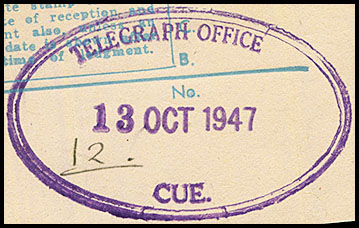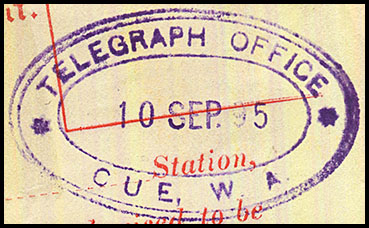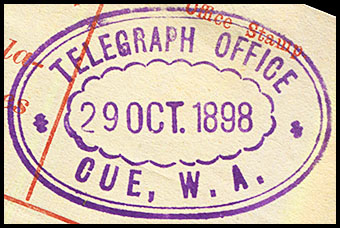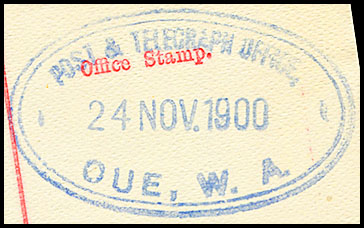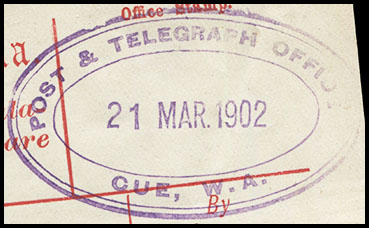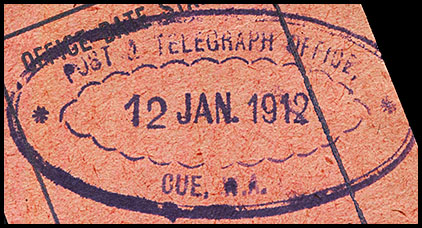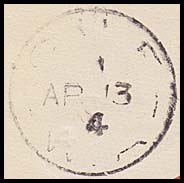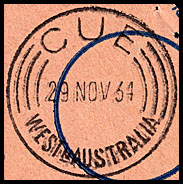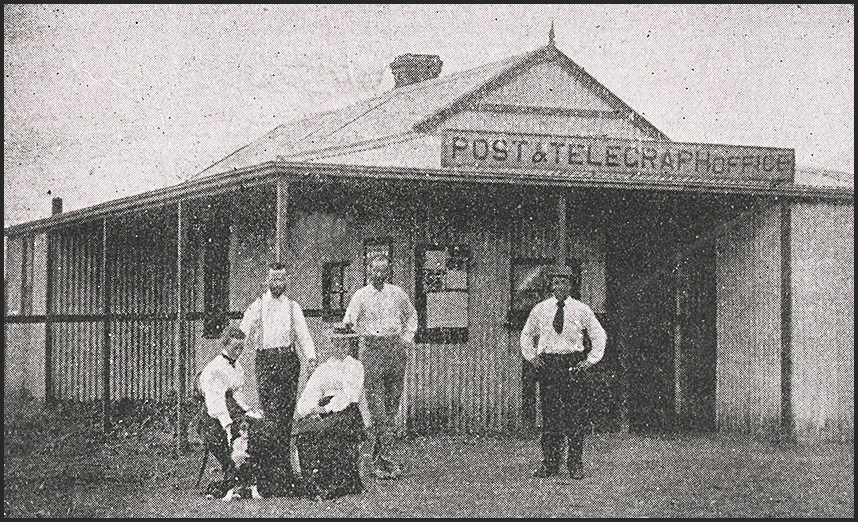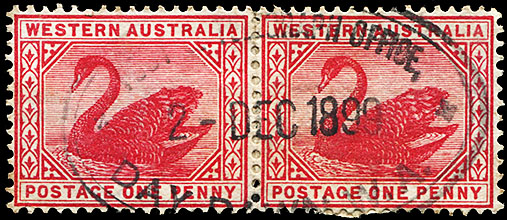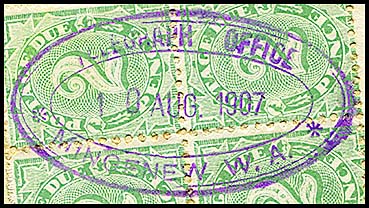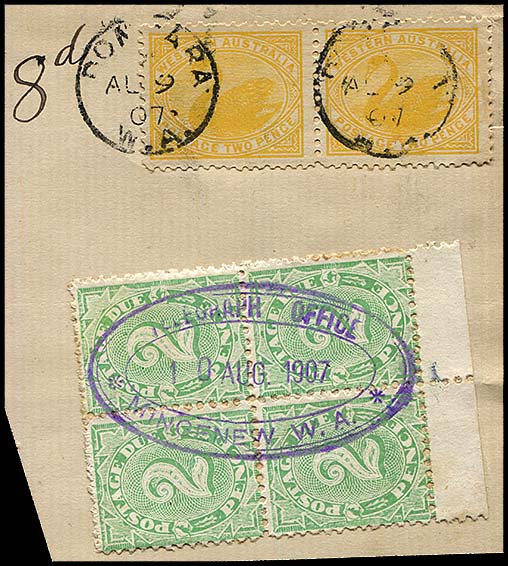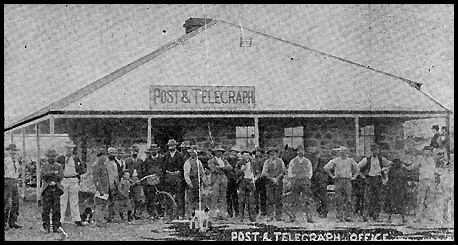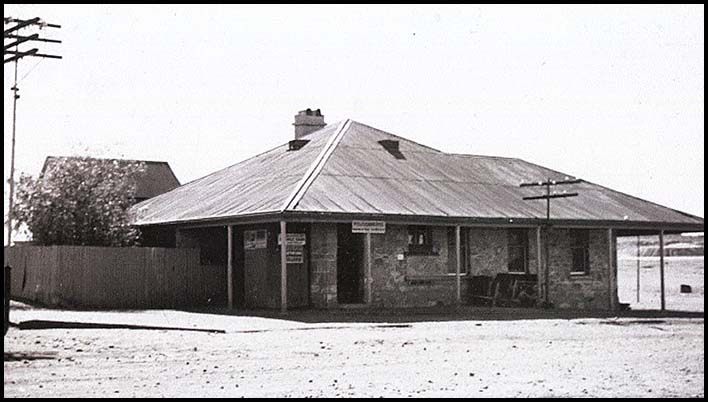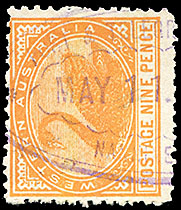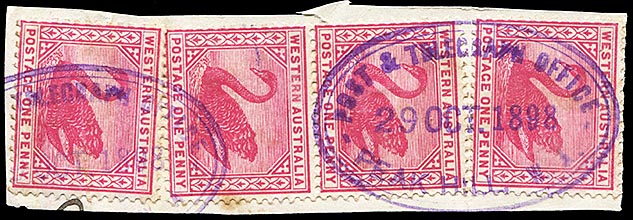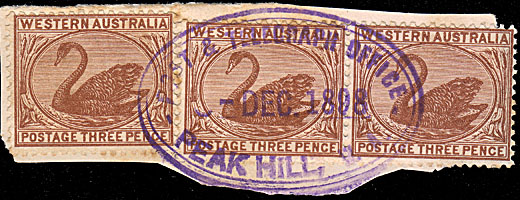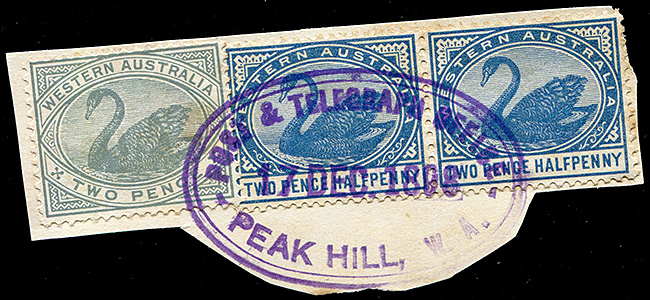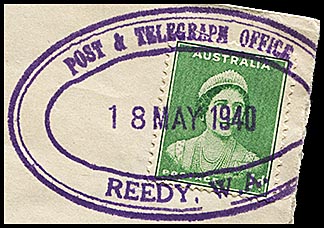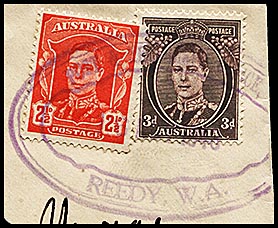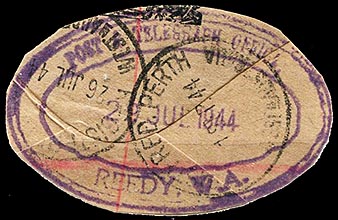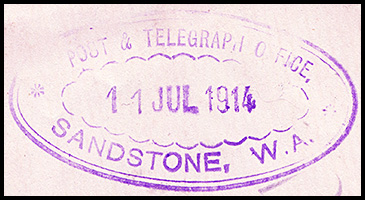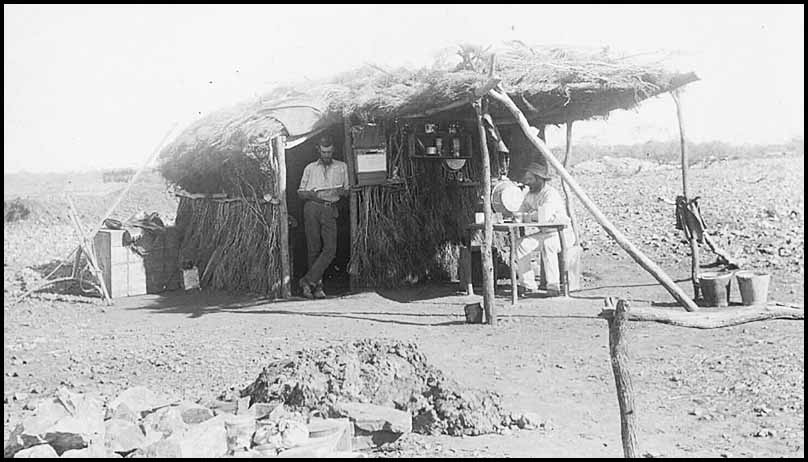Telegraph Offices in the Mid West region.
- Australia 1901-1988
- New South Wales
- Queensland
- South Australia
- Tasmania
- Victoria
- Western Australia
- International
- Special aspects
The Post & Telegraph Offices in the Mid-West region of Western Australia are listed in the table below:
The Mid West region of Western Australia encompasses a 472,336 square kilometres:
- the western part used to be called the Murchison. It centres on Geraldton and extends about 200 kilometres up the coast past Gregory and the Hutt River and down the coast past Dongara.
- the region extends a considerable distance inland to include the major mining areas around Cue, Mount Magnet, Meekatharra and Willuna and then down past Arrino and Carnamah.
|
A Post & Telegraph Office was opened at Abbotts on 17 August 1898 - the same year the town was established. It was closed on 31 October 1913. Abbotts was the place for a number of good gold-producing mines including the Black Iguana and the Abbotts mine. The town name was taken from the prospector Vincent Abbott who had changed his Croatian name of Vincent Vranjican. |
A RO6-P&TO oval date stamp was issued to the Office:
|
 19 April 1899. |
|
A Telegraph Office was opened on 1 June 1874. It was closed on 31 May 1880 but re-opened on 18 August 1893. It was again closed on 30 September 1898. On 1 January 1904, it was re-opened as an Allowance Office. |
|
|
The Telegraph Office was opened at Black Range in early April 1907. No special date stamp was issued to Black Range for use with telegraphs - surprising because such a date stamp was issued to nearby Sandstone. |
|
A Telegraph Office was opened on 1 June 1874. The Office was later upgraded to a Post & Telegraph Office in 1895. There is no record of an issue of a special date stamp for use with telegraphs at the Carnamah Office. |
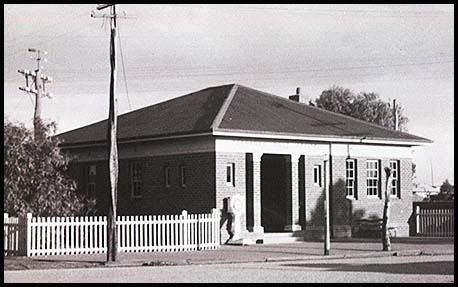 Carnamah Post Office about 1950. |
|
On the road to the north-west from Cue to Big Bell there was a town was originally called Dead Finish. Gold was discovered in the area at Dead Finish in 1888. At some stage, the town was renamed Cuddingwarra after the name of a nearby Hill (the name is derived from an Aboriginal language but its meaning has been lost). The town of Cuddingwarra was gazetted in 1895. An extension from the Cue - (Reedy) - Nannine telegraph line was completed in early November 1895. Telegraphic operation had to wait however for an Operator to be appointed. A Post & Telegraph Office was opened on 20 November 1895. The Office was downgraded progressively to an Allowance Office and then a Receiving Office before being closed on 3 December 1912. There were also three hotels. |
|
An RO4-P&TO date stamp is recorded for Cuddingwarra for use with telegraphs:
|
 No date. |
Cue was the chief town in the Murchison goldfields. It was often referred to as the Queen of the Murchison. Gold is a particular area was found by Tom Cue and two mates in February 1892. The area was called Cue's Rush then Cue's then Cue. The telegraph line from Geraldton via Mullewa was connected to Cue on 12 November 1894. Tenders were called in July 1894 for several public buildings including a Post and Telegraph Station. The Telegraph Office also opened on 12 November 1894. In 1896, Cue was the terminus of the railway line from Geraldton but there were plans to extend that line to Nannine. In addition to the gold, the town was surrounded by extensive pastoral interests. |
|
There was some satisfaction in the community when the Post and Telegraph Office finally opened: "Mr. Fels and his assistants are now fairly installed in their roomy and comfortable offices at the new Public buildings, their old tinpot structure on the other side of the street having finally been finally abandoned. The Post and Telegraph department of the Cue district is now properly housed and one standing cause for complaint is thereby removed. If only the better working of the wires could be ensured, there would be nothing left to grumble about" (Murchison Times, 9 October 1895). |
|
| 2. Telegram use:
The earliest recorded telegram forms used at Cue are:
|
|
| 3. Personnel:
August 1894: Mr. E. D. Fels was appointed Post and Telegraph Master at Cue;
February 1895: E. C. Beckwith to be provisionally and temporarily, telegraph linesman at Cue.
The Murchison Times of 25 May 1895 commented on salaries:
|
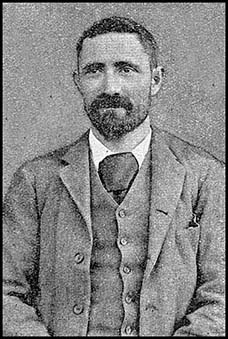 Mr. E. D. Fels was appointed as the first Post & Telegraph Master at Cue in August 1894. |
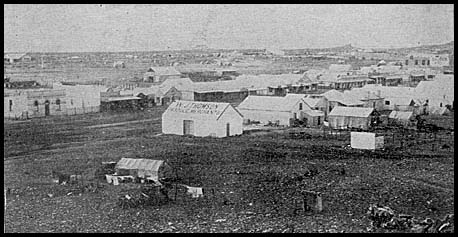 Cue about 1895. Source of first 3 pictures for Cue: Souvenir of the Postal, Telegraph & Telephone Departments of Western Australia, Christmas 1896. |
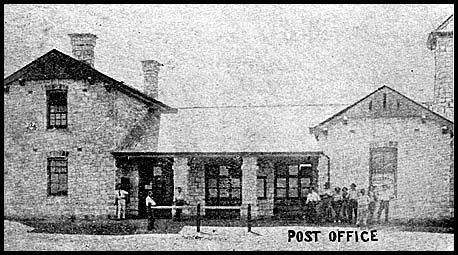 The Cue Post & Telegraph Office about 1895. |
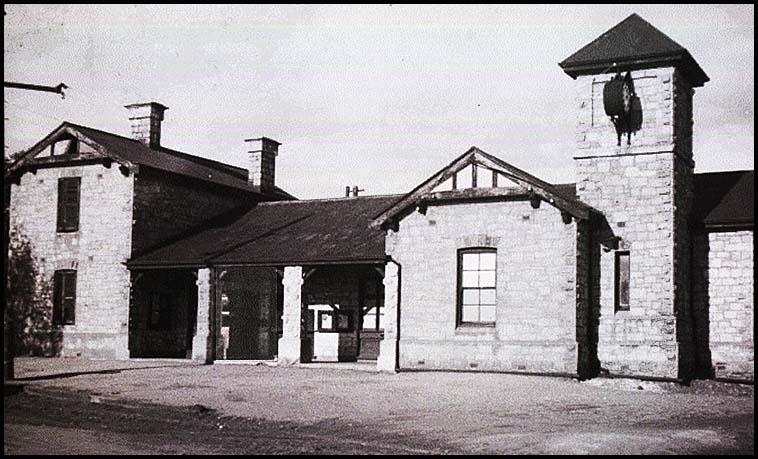 Cue Post & Telegraph Office about 1940. |
|
|
At least 10 types of rubber oval date stamps were issued to Cue for use with telegraphs. In summary, the following types are known: |
||
|
|
|
|
|
|
|
|
|
Diameter: 22 mm. Used on WI-DO-1A. |
Diameter: 26 mm. Used on AB-DU-3. |
Day Dawn.
The Post & Telegraph Office was established on 15 November 1894. It closed on 25 October 1930. Originally the settlement was informally called Four Mile - that being its distance from the town of Cue. For example, in a visit to Day Dawn by Premier Forrest in April 1894, the newspapers began by noting "On Thursday, April 26, the Premier drove down to the Four-mile from Cue and was met by a Reception Committee of the business people and the miners". The town was gazetted as the town of Bundawadra on 2 March 1894, renamed Day Dawn on 25 May 1894 and proclaimed a municipality on 24 May 1895. At the beginning of 1894, Day Dawn was the largest mine on the Murchison field. It had a 50 head battery of stampers and the return mostly averaged 3 to 4 ozs per ton. |
|
2. The nature of the requests for a Post and Telegraph Office. The Geraldton Victorian Express of 11 May 1894 reported the following discussion with Premier Forest during his visit to Four Mile (Day Dawn): "Mr. C. Chappie said that of their pressing wants the first was a Post Office. At present the butcher was attending to the mail. The mail bag was dumped on the floor, and there was no security in the scramble that ensued. A money-order office was required also, as working miners wished to send money to their wives and families in the other colonies. A letter was read re the telegraph line stating that it would pass through the Four-Mile on its way to Cue and Nannine. Mr Chappei hoped that this town would share in the benefits that were being bestowed on this goldfield. Mr Tait added that the butcher had refused any longer to act as postmaster without pay and asked for some temporary building as a Post Office - also that the Four-mile mail should come direct here without going to Cue first as it was a nearer and much better road. Mr Pell and Mr Wittenoom also spoke as to the necessity of some more satisfactory mail delivery". During the week after the P&T Office had opened, the residents of Day Dawn held a public meeting presided over by Mr. F. Whittenoom J.P. who was supported by his brother Mr. E. H. Whittenoom, M.L.C. who was visiting the district. The requests contained in the memorial were:
The Murchison Times of 25 May 1895 commented on salaries:
|
| 3. Telegram use.
The earliest recorded telegram form used at Day Dawn is a delivery form WC-DO-4Ca for a message sent from Perth to Day Dawn on 26 November 1894. |
| 4. Personnel:
November 1894: Mr. D. F. Vincent, who had just been appointed to the new Cue office was transferred to take temporary control of the new Day Dawn Office. In September 1895, he was confirmed in that position. |
|
The office was issued with at least four types of rubber oval office date stamp (types RO2, RO6 and RO7 - in two formats) which were used with telegraphs. |
|
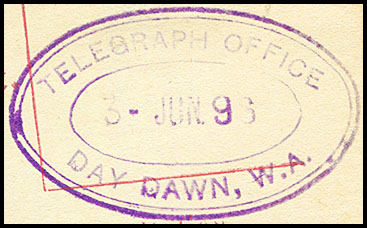 3 June 1896 - about 18 months after the Office opened. |
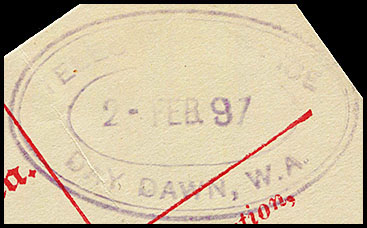 2 February 1897. Used on WC-DO-4Ca. Year confirmed on form. |
|
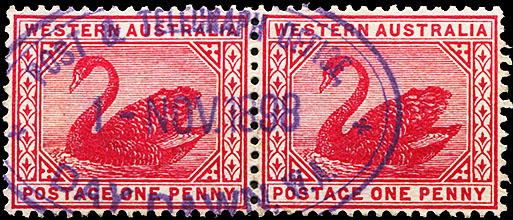 1 November 1898. |
|
|
|
 1899 June 16.jpg) 16 June 1899. |
|
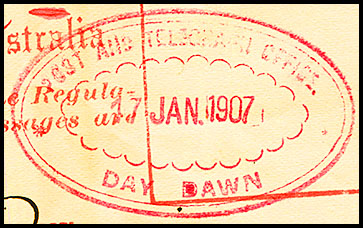 17 January 1907. |
|
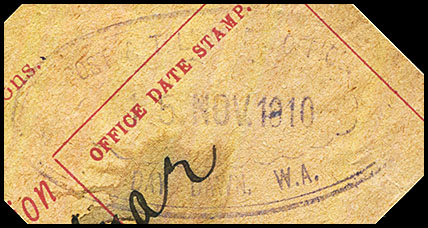 15 November 1910. |
|
A Post & Telegraph Office opened on 18 June 1874. Tenders were called for the erection of a new Post & Telegraph Office in August 1873. A Post Office had been established in February 1870 when Port Irwin was renamed. |
|
| A rubber oval Post & Telegraph date stamp (RO7-P&TO) was used at Dongarra:
Used: 28 June 1902. Size: 24 × 46 mm (e = 0.85). Rated: RRRR. Number in the Census: 1. |
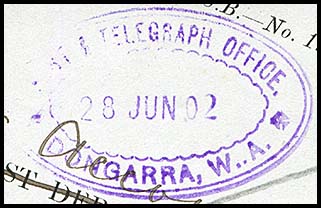 28 June 1902. |
| Geraldton/Champion Bay.
The Telegraph Office opened on 5 June 1874 as Champion Bay but soon after changed name to Geraldton. A good review of Geraldton and its place in the gold mining of the Murchison is given in The Inquirer and Commercial News of 11 January 1895. The prosperity of the Murchison gold fields combined with the significant exports of wool from the surrounding areas made this a very important Telegraph station. The call signal around the 1880s was GT. A relatively recent article published in the Western Mail on 23 June 1906 reported on conditions in the Office:
On 12 May 1913, a Coastal Radio Station was opened at Geraldton. |
||
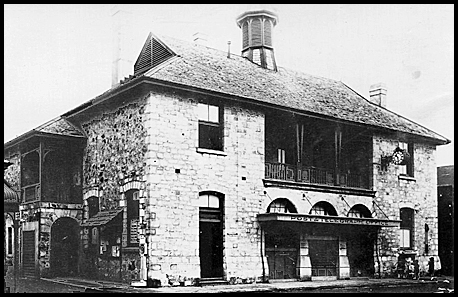 Geraldton Post & Telegraph Office about 1900. |
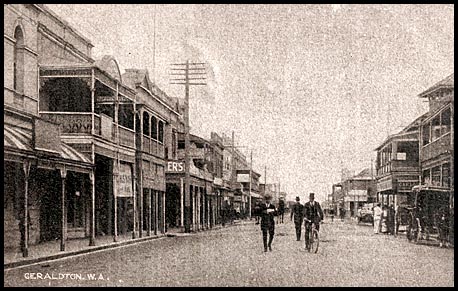 The township of Geraldton about 1900. |
|
|
The earliest recorded telegraph form used at Geraldton is a delivery form WC-DO- 3 for a message sent from Geraldton to Perth on 17 June 1881. |
||
| 3. Date stamps: | ||
| Telegrams were often marked with a straight-line Geraldton handstamp. |
 Example of the straight line handstamp on WI-DO-5A. |
|
| The Geraldton Post & Telegraph Office was issued with at least three types of date stamp for use with telegraphs: | ||
1. a TELEGRAPH OFFICE/GERALDTON steel date stamp.
|
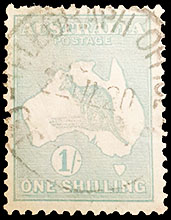 1/- turquoise Kangaroo on Map. Image by courtesy of Malcolm Brown, W.A. |
|
|
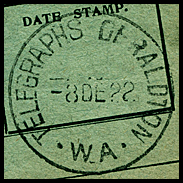 Telegraphs Geraldton/W.A 8 December 1922. |
|
|
||
|
In 1894, the staff at the Geraldton Post and Telegraph Office comprised:
Geraldton seemed to have attracted a range of excellent people to work in the Post and Telegraph Offices there. April 1897: Mr. H. L. Ottaway was appointed as Chief Telegraph Operator. January 1890: Mr. J. J. Griffin was appointed Postmaster and Telegraphist at Geraldton in January 1890. 6 January 1893: The Geraldton Victoria Express reported:
October 1893: The Geraldton Telegraph reported "Mr. Sinclair, Chief Operator at the Geraldton Telegraph Office, has been promoted to be Postmaster and Telegraphist at Derby. Mr. Sinclair, during his stay in Geraldton, has proved himself a most capable, obliging and reliable public officer, combining with efficiency in his work those equally indispensable qualifications in a Post or Telegraph officer, courtesy, civility and tact. While congratulating Mr. Sinclair on the step he is now invited to take on the ladder of the public service, we regret on personal grounds his approaching departure from Geraldton. Between the telegraph officers and the members of the press, constant intercourse very naturally exists and our hope is that the relations between Mr. Sinclair's successor and ourselves will be as mutually pleasant as have been those now about to be severed. Mr. Sinclair, we are sure, takes with him the good wishes of the people of Geraldton, whom he has served faithfully and well while he has been amongst them. Mr. Sinclair is son of our respected pier master, Mr. John Sinclair, of Bunbury, and first entered the post and telegraph service under Mr. Woodrow, our present postmaster". 29 September 1897: Yet another excellent person in the Geraldton Telegraph Office was promoted. The Geraldton Advertiser recounted "His numerous friends in the district will be pleased to learn that Mr. E. H. Innes, who has for the last five years ably filled the position of Postmaster at Geraldton, is about to receive merited promotion. Mr. Innes has, we understand, been offered the responsible post of Resident Inspector o£ Posts and Telegraphs on the Eastern goldfields and, no doubt, will accept it. We tender him our warmest congratulations on this substantial recognition of his services while at the same time expressing regret that his acceptance of the promotion will deprive Geraldton of a most conscientious and courteous Postmaster". February 1898: Mr. K. H. Innes, the Post and Telegraph Master, was appointed Inspector of Post and Telegraphs and based at Coolgardie. |
|
Tenders were called for the erection of a new Post & Telegraph Office in January 1873 (and again in August 1873). The Gazette of 3 February 1874 noted that "the tender submitted by Richard Lucas to build a Post and Telegraph Office at Greenough for £175 had been accepted". A Post & Telegraph Office was opened on 5 June 1874. A Post Office had opened previously on 1 May 1862. On 23 April 1884, the Inquirer reported "The measles are proving very trouble some at the Greenough, where the Post and Telegraph Mistress has been attacked by the dreaded disease". It was certainly a major widespread outbreak with the Leader of the Telegraph Survey team then in Carnarvon being similarly affected. |
|
Personnel: September 1875: Miss Waters, Post Mistress, resigned to become Mrs. Jas. M. Innes - that gentleman then being Postmaster at Newcastle. |
|
A transmission form was used at Green Ponds, Tasmania (date unknown - but maybe about 1880) to utilise a major development. The South Australia connection to Western Australia at Eucla had been made in December 1877. This message was sent from Green Ponds (on the Hobart-Launceston line in Tasmania) to Greenough utilising the inter-colonial link. This form is the earliest evidence of a message being transmitted over that inter-colonial link. |
|
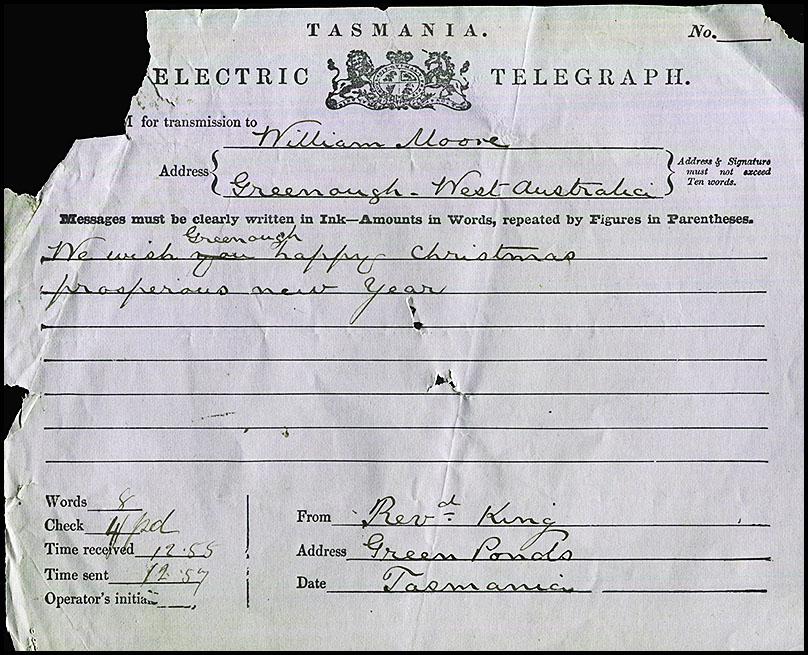 |
|
Date stamps: A rubber oval Telegraph Office date stamp (RO6-TO) was issued at Greenough::
|
|
|
The Post & Telegraph Office opened 2 September 1897 when the line was extended from Yalgoo. It is now the center of the Silver Lake Resources mining operations for the Deflector mine. The P&T Office was downgraded to an Allowance Office on 1 September 1901. |
|
|
The town was founded by Joseph Lucas Horrocks - a convict who had been transported to Western Australia in 1851. He had been convicted of "uttering and forgery". He was pardoned in 1856. Telegraph Office ... |
|
A rubber oval Post & Telegraph Office date stamp (RO2-P&TO) was issued to the office:
|
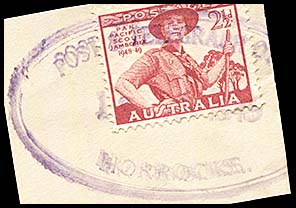 12 ??? 1949. |
| Meekatharra.
On 14 November 1906, the Kalgoorlie Miner reported that "the Postmaster - General had informed Mr. H. Mahon, M.P., that his request for the establishment of an official post and telegraph office at Meekatharra has been granted. The office will be opened as soon as the necessary premises have been provided, and without any guarantee from the State Government. The postmaster will also perform mining duties, and the remuneration for this will be subsequently arranged on an equitable basis, according to the work done and the accommodation provided". |
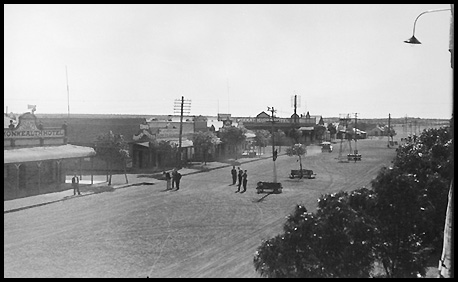 Meekatharra - street scene in 1920. Source: WA Library 217 255 PD. |
Two formats for date stamps with Post & Telegraph Office are recorded as having been issued to Meekatharra for use with telegraphs: |
|
|
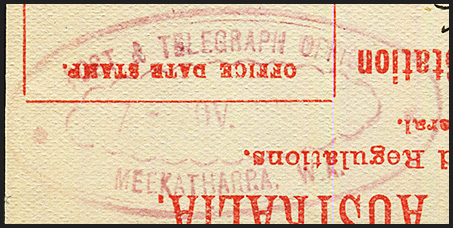 7 November (no year showing). Used on WI - DO - 3. |
|
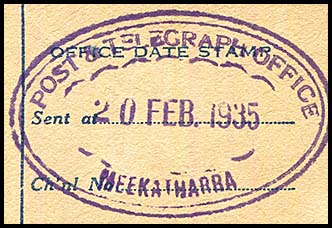 20 February 1935. |
| In addition, three formats with the TELEGRAPH OFFICE inscription were issued. |
|
|
 13 June 1950 - only recorded example. |
|
 24 October 1962 - only recorded example. |
|
 16 December 1971 - only recorded example. |
|
A Telegraph Office opened at Melville on 13 November 1895. |
| Mount Magnet.
Telegraphic communication was opened to Mount Magnet on 15 March 1896 with the office housed in a temporary location. On 19 May, 1897, the Gazette advertised for tenders to construct the Mount Magnet Post and Telegraph Office. A Post Office had operated since April 1893. On 17 July 1896, the Inquirer reported that "The new registrar's office and warden's court were used for the first time July 15. The building is a considerable improvement on the old canvas structure. The erection of a solid Post and Telegraph office is absolutely necessary, the officers being severely handicapped in the tin building which they now occupy". Personnel: July 1896: Mr. Thomas Cain was appointed Telegraph Assistant. February 1907: Mr C. F. Annear who had capably filled the position of Post and Telegraph Master at Mt Magnet during the previous four years leaves for Davyhurst on Friday next. Mr Annear was succeeded by Mr P. J. Leyden, relieving officer, who filled the position of Post and Telegraph master till the arrival of Mr G. W. Leaf who had been appointed Post and Telegraph master there. |
|
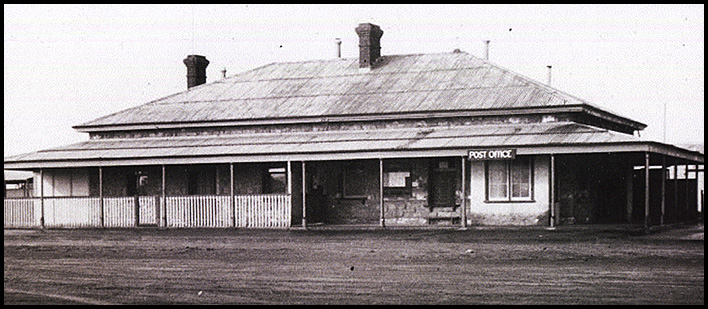 Mount Magnet Post & Telegraph Office about 1940. |
|
Three rubber oval date stamps are recorded as having been used at Mount Magnet with telegraphs: |
|
|
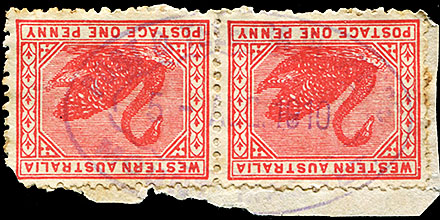 5 August 1910. |
|
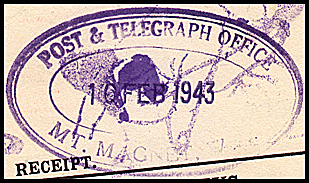 10 February 1943. |
|
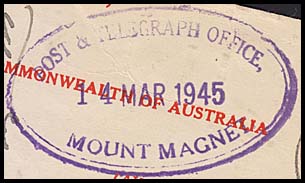 14 March 1945. |
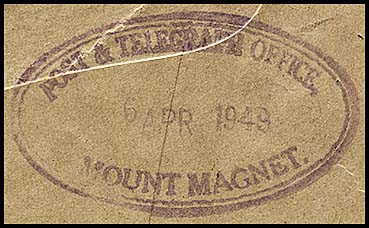 6 April 1949. |
|
| The usual steel date stamp used for postal purposes was also applied to telegrams. | 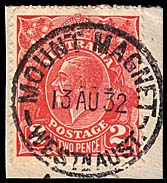 Mount Magnet on 2d red KGV. 13 August 1932. |
|
The Post & Telegraph Office was commenced on 12 October 1894 and opened the following day. A Post Office had been opened in September 1892. The Geraldton Murchison Telegraph of 19 October 1894 carried the following: "Since writing my last, Mullewa has attained a more enviable position than many more pretentious towns in this colony, as through the unceasing and indefatigable energy of Mr. Hamilton Cuming, of the Terminus Hotel, ably assisted by Mr. E. T. Peate, the general manager from Messrs. Faiz & Tagh Mahomet, the new Post and Telegraph Office has been opened since Friday, the 12th inst., and a great benefit has accrued to the general public thereby. There is now no difficulty in transacting postal business. The gentlemen in charge, Mr. Bilby, is most courteous, and the residents here should be thankful to the department for sending along the right man for the right place. The first telegraphic message transmitted from Mullewa was to Sir John Forrest from Messrs H. Cuming and E. T. Peate, and read as follows: "We desire to congratulate you upon the prompt action taken in opening the Telegraph and Post Office here, which meets the demands of all portions of the community and we desire to thank you on behalf of the residents of Mullewa. We believe this to be the first message sent from the Murchison District". The following reply was received from Sir John dated 13-10-94, 4.12 p.m.: "I thank you for your congratulations on the opening of the Post and Telegraph Offices at Mullewa and I hope and believe that the extension of the telegraph system to all important centres on our goldfields must assist in promoting the advancement and welfare of the colony. (Signed) JOHN FORREST, Premier." The honour of transmitting and receiving the very first telegraphic message at Mullewa, therefore. rests on Messrs Cuming and Peate, who also wired the following message to the Hon. Mr. Henty, M.L.C.: "We desire to congratulate and thank you for your prompt action in urging on the Government the speedy opening of the Telegraph and Post Office at this place, which meets an urgent want and opens this morning, and this is the second message sent through from here. The first is to the Premier thanking him also on behalf of the people of Mullewa. Referring to the opening of the new Post Office, I do not think there will be anyone more heartily glad than Mrs. Judge, the late Post Mistress, who must have been simply worried to death, as her arduous duties in managing her hotel must be more than enough for any woman without the trouble of having to leave off her work to look for letters etc. in her busiest moments. Her patience and kindness as Post Mistress at Mullewa has made her popular and deservedly so". |
|
| Two date stamps were issued to the office for use with telegraphs: | |
A rubber oval Post & Telegraph Office
|
 Unknown date - only recorded example. |
|
|
|
A Post Office was opened on 20 November 1866 when it replaced Wanerenooka. The Office was upgraded to a Post & Telegraph Office on 5 April 1878. Miss Commerford was promoted to the position of Postmistress and Telegraphist at Northampton from Geraldton in January 1893 (see above). |
|
The Office was provided with a rubber oval date stamp (RO7-P&TO):
|
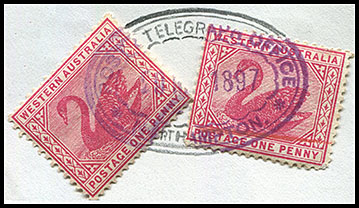 10 M?? 1897. |
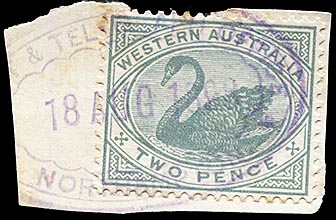 18 August 1898. |
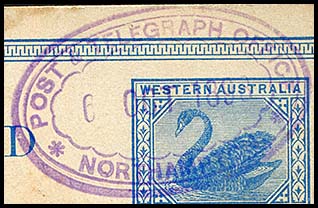 6 October 1898 - detail. |
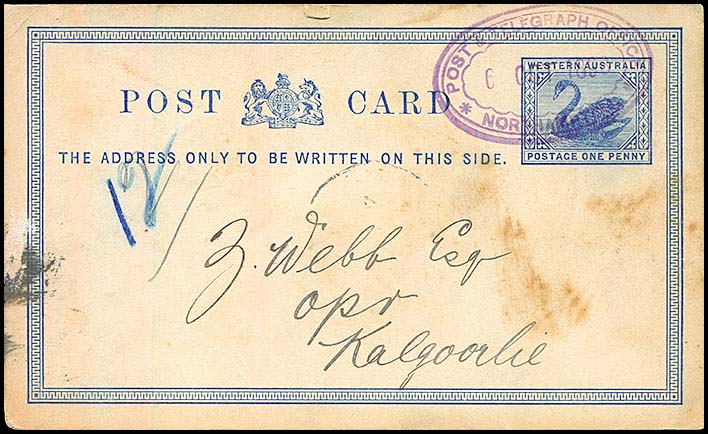 Front side of postcard of 6 October 1898. |
|
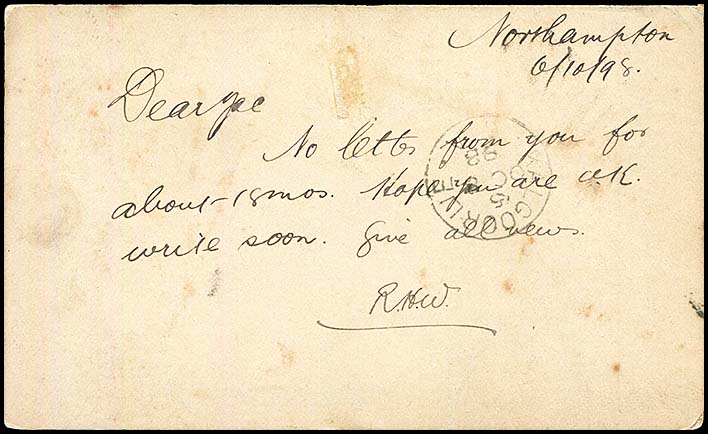 Reverse side of postcard (seeking news) - 6 October 1898. |
|
|
The Post & Telegraph Office opened on 10 October 1898. A Post Office had been opened in December 1894. Peak Hill is situated between the Gascoyne and Murchison Rivers about 120 miles from Nannine. Nearly all the leases for gold mining were owned by one company. The town was established in 1892 and gazetted in 1897. Up to 1913, about 270,000 ozs of gold were extracted. A further 600,000 ozs were extracted in the 1980s. In 1898, the town had 190 people - 180 were males and 10 were females. |
|
Three formats for oval rubber Post & Telegraph date stamps have been recorded as having been issued to Peak Hill for use with telegraphs:
|
|
Prestige Auction, November 2013 Lot 520. |
|
ACE Auctions, July 2018, Lot 956. |
|
|
|
|
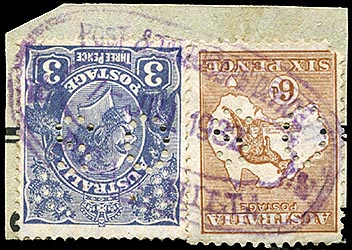 7 July 1932 (only recorded example). |
| Reedy.
The Post & Telegraph Office was opened at Reedy on 16 September 1935 - to overcome a most extraordinary approach to line construction using the top wire of a fence. Reedy is located in the Murchison between Cue and Meekatharra. The town was Gazetted in 1934 after several gold discoveries during the early 1930s. |
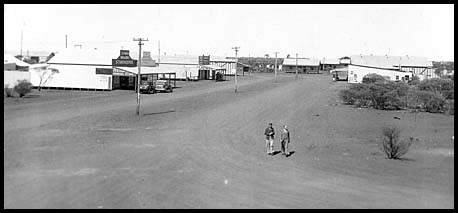 Reedy in the 1930s (probably mid 1930s given the telegraph/telephone posts in the town). By courtesy of the State Library of WA. |
|
| A rubber oval date stamp (RO6-P&TO) was issued to the Office for use with telegraph work. There were probably two or three rubber stamps prepared.
NOTE: this example has a dot between the digits for the day.
|
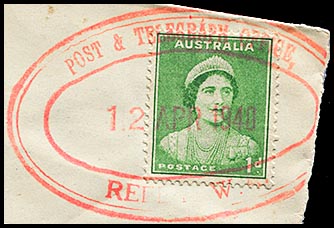 12 April 1940. The only known date stamp from Reedy struck red. |
|
2. Used in violet: 18 May 1940. |
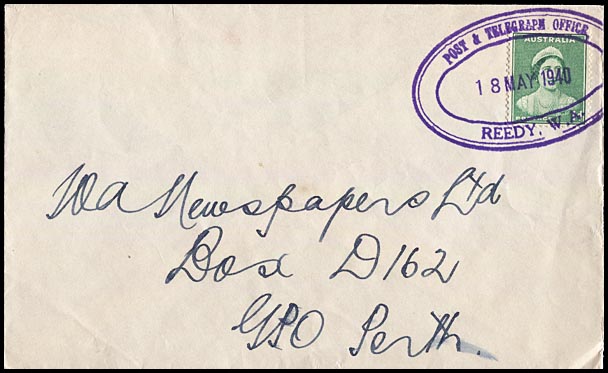 18 May 1940 - used as a violet strike on a cover to Perth. |
|
Detail of the strike on the cover at the right. |
||
The other three known date stamps from Reedy are struck in violet. The distortion to the inner frame to the left of R(EEDY) is much greater. The break under W is still present.
|
The inner oval is distorted. This feature is considered as being due to wear and not being a change to the design. Hence it is not classified as RO7. |
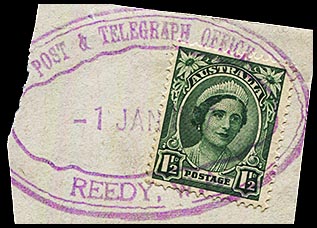 1 January 1947 (the 4 is indistinct). The inner oval shows similarities to the distortion shown at left on May 1940. |
The distortion in the inner oval is slightly more pronounced that it was in 1940. |
||
| Sandstone.
Sandstone was established as a town in 1894 as a result of the gold rush affecting nearby Mt. Magnet and Cue. It was closely allied to Black Rock. A survey for the line had been completed to Sandstone in early 1907 and soon after a report indicated that the site for the telegraph office was to be lot 32, at the corner of Oroya and Hack streets, and' immediately opposite Messrs. Clarke and Co.'s store. The approval for the purchase of the site was given in late May 1907. A Receiving Office was opened on 15 March 1907 and upgraded to a Post and Telegraph Office on 20 May 1907. The railway from Mt. Magnet was completed in 1910. Personnel: May 1907: Mr. Duggan, who was assisting Mr. Egan, Postmaster at Nunngarra, took charge of the new office and another officer arrived from Perth and joined Mr. Egan. |
|
The Office was issued with a rubber oval Post & Telegraph Office date stamp (RO7-P&TO):
|
Used on reverse side of an OHMS envelope Returned to Sender. |
|
A Post & Telegraph Office was opened on 5 November 1900. Wiluna was previously known as Lakeway which was an office designated as a Receiver of Mail Bags. |
|
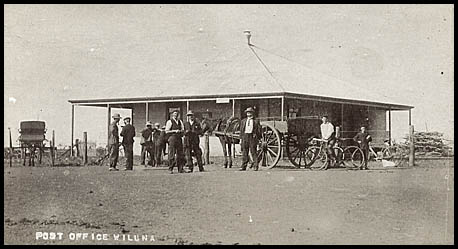 |
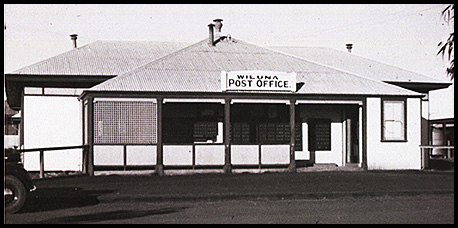 Wiluna P&TO about 1940. |
The Office was issued with a rubber oval Post & Telegraph date stamp (RO4-P&TO).
|
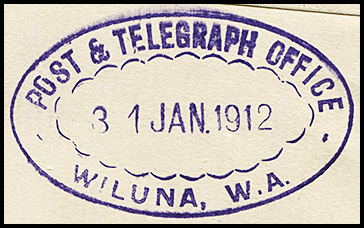 31 January 1912. |
|
A Telegraph Office opened on 24 December 1897. It was upgraded to a Post & Telegraph Office in 1904. |
|
It is reported that the Office was issued with a rubber oval POST & TELEGRAPH OFFICE date stamp (RO?-P&TO).
|
|
|
A Post and Telegraph Office was opened at Yalgoo on 5 April 1895. No Oval date stamp was issued to the Office. |
|
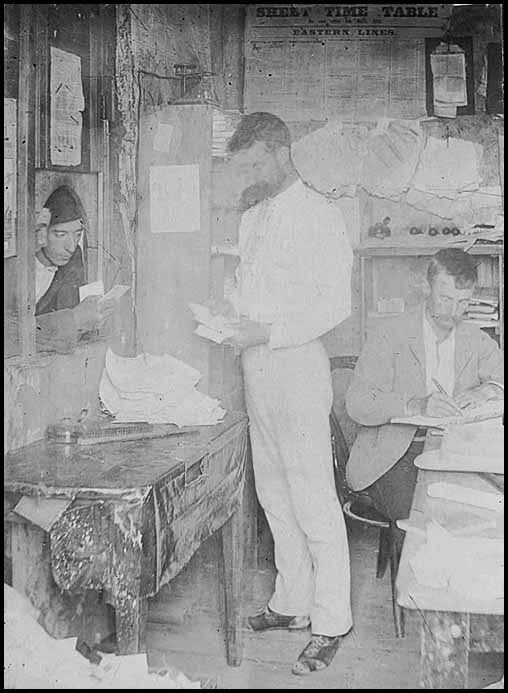 Inside the Yalgoo Post & Telegraph Office. |
